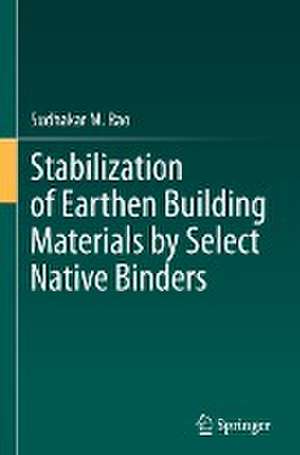Stabilization of Earthen Building Materials by Select Native Binders
Autor Sudhakar M. Raoen Limba Engleză Hardback – 24 dec 2023
Preț: 894.46 lei
Preț vechi: 1090.81 lei
-18% Nou
Puncte Express: 1342
Preț estimativ în valută:
171.17€ • 177.69$ • 142.73£
171.17€ • 177.69$ • 142.73£
Carte disponibilă
Livrare economică 03-17 martie
Preluare comenzi: 021 569.72.76
Specificații
ISBN-13: 9783031489860
ISBN-10: 3031489861
Pagini: 223
Ilustrații: XIX, 223 p. 129 illus., 119 illus. in color.
Dimensiuni: 155 x 235 mm
Greutate: 0.54 kg
Ediția:1st ed. 2023
Editura: Springer International Publishing
Colecția Springer
Locul publicării:Cham, Switzerland
ISBN-10: 3031489861
Pagini: 223
Ilustrații: XIX, 223 p. 129 illus., 119 illus. in color.
Dimensiuni: 155 x 235 mm
Greutate: 0.54 kg
Ediția:1st ed. 2023
Editura: Springer International Publishing
Colecția Springer
Locul publicării:Cham, Switzerland
Cuprins
Chapter 1: Characterization of soils used in earthen building materials.- Chapter 2: Role of soil suction in the engineering behavior of earthen building materials.- Chapter 3: Stabilizers for earthen building materials.- Chapter 4: Characteristics of cement stabilized and cement +wood ash stabilized compressed earth blocks.- Chapter 5: Stabilization of adobes by plant fibers.- Chapter 6: Stabilization of adobes by cow dung particles.- Chapter 7: General conclusions.
Notă biografică
Dr. Sudhakar Rao is a Retired Professor from Department of Civil Engineering, Indian Institute of Science, Bangalore. His major research contributions are on elucidating the role of suction, climate and physico-chemical forces in the mechanical response of unsaturated and saturated soils, use of native binders in stabilization of raw earth, and re-use of wastes in civil engineering applications, such as the use of fly ash in synthesis of geopolymer sands. He has designed and taught undergraduate and graduate level courses in environmental sciences and geoenvironmental engineering. He was a Principal Investigator of several Sponsored Research Projects that focused on indigenous earth deposits stabilized with native binders, design of clay barriers to contain hazardous wastes and re-use of hazardous wastes, such as phosphogypsum sludge, bone char sludge and fluoride contaminated magnesia in civil engineering applications. He has published more than 100 papers in leading International Journals and has supervised 24 Ph.D. and 7 M.Sc. (Engineering) dissertations. He has co-edited one book and has contributed chapters to five edited books. He is serving as the associate editor of two journals and the editorial board member of one journal. He was a visiting scientist at McGill University, Ryerson University, Canada and Cardiff University, UK.
Textul de pe ultima copertă
Increased environmental and energy concerns have renewed global interest in raw earth as a building material. Low-energy requirements, low-cost, high availability at construction sites, and favorable engineering properties make (EBMs) an attractive alternative to conventional cement-based construction materials. Though the use of native binders to improve soil properties has garnered attention in recent literature, the available knowledge has not been covered in a single document. This book highlights the key soil properties that determine the mechanical performance of earthen building materials, importance of unsaturated soil mechanics in the engineering behavior of earthen building materials, the different types of stabilizers used to improve the engineering performance of earthen building materials including the use of select native binders, the characteristics of compressed earth blocks stabilized with cement and cement + wood ash additives and the improvement in the engineering properties of adobes stabilized with plant fibers and cow dung.
Caracteristici
Covers the use of native binders for soil stabilization in earth constructions Highlights the importance of unsaturated soil mechanics in the engineering behavior of EBMs Discusses the types of native binders used for stabilizing different soil types
